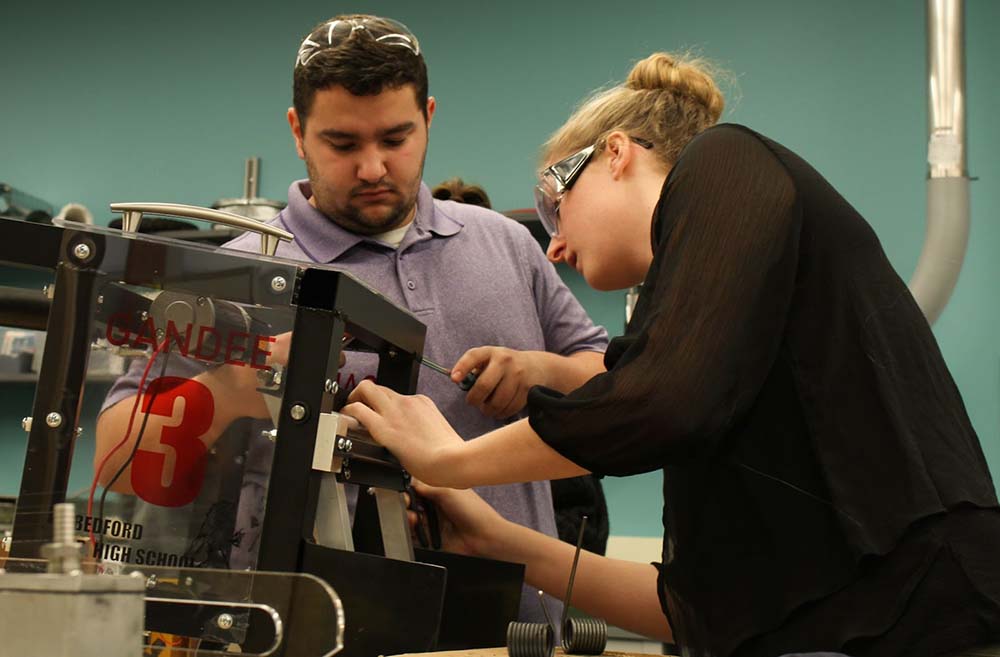

When David Kwabi, ME assistant professor, needed a component for a novel device he and a team of colleagues were developing, he reached out to the leadership of ME’s senior Capstone Design course, ME 450, to sponsor a course project.
“There really was no off-the-shelf solution; we knew we would have to build something customized,” Kwabi said. “ME 450 students were perfectly positioned given their expertise in machining, fluid mechanics and control systems.”
For the full Winter 2022 semester, an ME 450 student team worked closely with Kwabi and two graduate students in his lab. Collaboratively, the team designed and tested a working prototype of the component: an automated electrolyte delivery system for electrochemical desalination.
The collaboration was productive for both Kwabi’s research and the ME 450 student team.
“The device the team came up with performs almost exactly to the specifications we requested, has a small footprint, and is straightforward to operate,” he said. “It was an amazing synergy between research and education.”
The project is just one example of the real-world challenges posed by project sponsors that students take on in the intensive, four-credit Capstone Design. The course is the culmination of the ME department’s “x50” Design and Manufacturing course sequence.
Other examples of Capstone Design student projects include a realistic CAD model and 3D-printed prosthetic eye, one of the world’s largest, movable, free-standing Rubik’s Cubes (now on display on North Campus), and a carrying case for sensitive measuring equipment for a proposed NASA spaceflight mission. Many other examples can be found in the course portfolio.
The hands-on experiences and engineering analysis skills that students acquire through previous courses in ME’s Design and Manufacturing spine—ME 250 and ME 350—lay the foundation for the challenges of ME 450.
Capstone Design then pushes students further, to use a structured design process—including advanced engineering analysis and simulation—to solve sophisticated, open-ended mechanical engineering design problems while also applying principles of socially engaged design.
“By their senior year, our students are ready to go beyond traditional engineering analysis to consider the broad social and societal issues that inform their project—who benefits and who may be harmed—as well as environmental sustainability,” said Arthur F. Thurnau Professor Steve Skerlos, current ME 450 course leader.
It’s not a casual investigation. “We train ME 450 students to consider the social, ethical, and environmental aspects of engineering work on equal footing with the technical aspects,” he added.
ME 450 projects come from all sectors—industry and startups, community-based nonprofit organizations, national research laboratories as well as faculty research labs and student-led campus organizations.
“Projects selected for the course are carefully vetted,” said Eliza Austic, course coordinator. “Inclusivity, environmental impacts, the bigger societal picture—considering these is integral to every project we choose for student teams to work on.”
Sponsors must demonstrate an interest in collaborating closely with their assigned student team. “Mentors are deeply invested and engaged in the course and in the design process, providing high quality feedback and guidance all semester long,” Austic added.
At the end of the course, students present their solution in the form of a working prototype or, if the project dictates, a computer model at the U-M Engineering Design Expo. In some cases, students go on to file for patents, launch startups, or are hired by sponsors for jobs following graduation.
The course gives students plenty to talk about during their job search. "I’ve brought up my 450 project in countless interviews,” said Jeremy Punch, a Heller Industry Scholar who took ME 450 in Fall 2020. “It helps you answer basic interview questions like, ‘What did you do when something you tried didn’t work?’ and ‘How did you adapt?’ I’ve given specific examples from the course project. They’re great experiences to talk about during interviews because they’re real-world design projects that you’ll see in industry."
The ME 450 experience not only enriches students’ education but sponsors’ work as well. “Sponsors gain the benefit of fresh eyes on all aspects of the design process, from problem definition to ideation and validation,” Skerlos said. “It often leads to understanding the challenge they’re facing from new social, economic and technical perspectives.”
Sponsors also benefit from the creativity and energy students bring to concept generation. “Couple these with the deep engineering analysis, specifications-driven concept selection and verification through simulation or prototyping—sometimes both—and sponsors are often blown away by the degree of innovation students show,” Skerlos said.
“Startups seeking venture funding and companies at all stages that are working on patent applications tend to find the students’ testing, data, and final reports especially helpful,” Austic added. “To have that analysis as well as a physical prototype you can work with and show potential investors can be a game-changer for emerging companies.”
The intense hands-on work students do in Capstone Design is complemented by a strong instructional component. With a recent Teaching Innovation Pilot grant, Skerlos and Arthur F. Thurnau Professor Kathleen Sienko, ME 450 co-coordinator in AY21-22, have implemented a series of self-paced modules, or learning blocks, that students can complete on their own schedule.
The learning blocks replace traditional class lectures and, although the modules are self-paced, students must complete knowledge checks, application tasks, and reflection exercises, which aren’t usually feasible in a lecture setting. Shifting to learning blocks has also freed up class time for faculty to meet with individual student project teams.
“The learning block approach has let us achieve a deeper level of engagement,” Skerlos said. “Students’ ability to confidently apply course content to their projects has skyrocketed.”
Like Kwabi, Skerlos sponsored a recent Capstone Design project. “One of the teams I worked with found an original strategy for achieving an engineering goal that had eluded researchers for over a decade,” he said.
He and the student team quickly filed for a provisional patent. “That was just one of many cases where I’ve seen students combine creativity, analysis, and holistic thinking to benefit both industry and our broader society.”